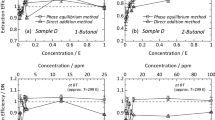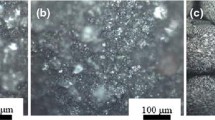Abstract
High-ammonia latex concentrate prepared from doubly-concentrifuged fieldHevea latex was exhaustively dialyzed to remove any residual water-soluble non-rubber constituents. The specially purified latex was then treated with specific chemical reagents to modify the surface ionogenic groupings originally present on the latex particle surface. The electrophoretic mobility of the modified latexes was investigated as a function of pH. The change in electrokinetic properties of the surface-modified latex was explained in terms of chemical modification to the ionogenic groups of the adsorbed layer of proteins and long chain fatty acid soaps on the latex particle surface, the negative charges of which are primarily responsible for the colloidal stability of the latex. For comparison direct extraction of the long-chain fatty acid soaps from the specially purified latex by solvent was also carried out. Present results indicate that the number of carboxyl groups from the adsorbed long-chain fatty acid soaps plays a major role in the stabilization of the latex concentrate. In comparison the contribution of negative charges from the adsorbed proteins towards the stability of the latex is of less importance.
Similar content being viewed by others
References
Ho CC, Ng WL (1979) Colloid Polym Sci 257:406–412
Gittens GJ, James AM (1963) Biochim Biophys Acta 66:237–249
Ward PD, Ambrose EJ (1969) J Cell Sci 4:289–298
Mehrishi JN (1970) Europ J Cancer 6:229–248
Lee KC (1972) J Cell Sci 10:229–248
Barnard D, Dawes K, Mente PG (1975) Proc Inter Rubber Conf 4:215
Baker CSL, Barnard D (1987) In: Lal J, Mark JE (eds) Advances in Elastomers and Rubber Elasticity. Plenum Public, New York, p 175–188
Hill MJ, James AM, Maxted WR (1963) Biochim Biophys Acta 75:402–413
Chen SF, Ng CS (1984) Rubber Chem & Tech 57:243–253
Chappele EW, Luck JM (1957) J Biol Chem 229:171–9
Douglas HW (1959) Trans Faraday Soc 55:850–6
Seaman GVF, Heard DH (1960) J Gen Physiol 44:251–268
Heard DH, Seaman GVF (1961) Biochim Biophys Acta 53:366–374
Bangham AD, Pethica BA, Seaman GVF (1958) Biochem J 69:12–9
Edsall JT, Wyman J (1959) Biophysical Chemistry Vol 1. Academic Press, New York
Hill MJ, James AM, Maxted WR (1963) Biochim Biophys Acta 71:740–2
Walujono K, Scholma RA, Beintema JJ, Anton M, Hahn A (1975) Proc Inter Rubber Conf 2:218–231
Chen SF (1979) Proc Inter Rubber Conf (Venice) p 215
Author information
Authors and Affiliations
Rights and permissions
About this article
Cite this article
Ho, C.C. Changes in electrokinetic properties of natural rubber latex after surface chemical modifications. Colloid & Polymer Sci 267, 643–647 (1989). https://doi.org/10.1007/BF01410442
Received:
Accepted:
Issue Date:
DOI: https://doi.org/10.1007/BF01410442




